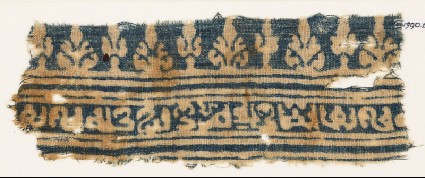Newberry Collection
Explore Percy and Essie Newberry's important collection of textiles including Islamic embroideries and Indian block-printed fragments.

Collection trails: 1 object
Show search help- Reference URL
Actions
Textile fragment with inscription, lines, stylized palmettes, and possibly trees
-
Details
- Associated place
-
Asia › India › west India › Gujarat (place of creation)
- Date
-
possibly early 12th century (1101-1130)
Fatimid Period (AD 909 - 1171)
- Material and technique
- cotton, block-printed with resist, and dyed blue
- Dimensions
-
24.5 x 9 cm max. (length x width)
along length/width 9 / 13 threads/cm (thread count)
- Material index
- Technique index
-
assembled › woven › plain woven,woven › plain woven,dyed › resist dyed,coloured › dyed › resist dyed
- Object type index
- No. of items
- 1
- Credit line
- Presented by Professor Percy Newberry, 1941.
- Accession no.
- EA1990.150
-
Further reading
Barnes, Ruth, Indian Block-Printed Textiles in Egypt: The Newberry Collection in the Ashmolean Museum, Oxford, 2 vols (Oxford: Clarendon Press, 1997), no. 142 on p. 38 (vol. ii), vol. ii p. 39, illus. vol. ii p. 38 fig. 142
Pfister, R., Les toiles imprimées de Fostat et l'Hindoustan (Paris: Les Éditions d'Art et d'Histoire, 1938), cat. 69, pl.XXVIa
Location
-
- currently in research collection
Objects are sometimes moved to a different location. Our object location data is usually updated on a monthly basis. Contact the Jameel Study Centre if you are planning to visit the museum to see a particular object on display, or would like to arrange an appointment to see an object in our reserve collections.
Publications online
-

Indian Block-Printed Textiles in Egypt: The Newberry Collection in the Ashmolean Museum, Oxford
Band of inscription which repeats itself after 19 cm., four white lines on either side of the band, and a row of stylized ?trees and palmettes. The resist defines the design, the background is blue.
The inscription reads, in order of printing: 'and perpetuity to its owner...Blessing and...'. Pfister discusses a similar fragment which has the same inscription. The type of script derives from a 11th- or early 12th-century Fatimid source. This may suggest an early 12th-century date for the textile.
© 2013 University of Oxford - Ashmolean Museum

